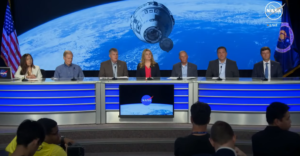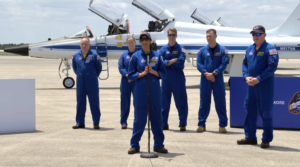Starliner Ready for Human Spaceflight Debut
Following a Flight Readiness Review today, Boeing and NASA officials confirmed Starliner is ready for launch on Monday with two NASA astronauts aboard. Starliner has flown twice already without a crew. The first time revealed so many problems that Boeing decided to launch it empty a second time to ensure everything worked as expected. That flight was a success and although the path from then until now has been rather bumpy, the head of Boeing’s commercial crew program said today there are “zero constraints” to launch.
NASA Administrator Bill Nelson and other NASA officials spoke with reporters at Kennedy Space Center along with Boeing Vice President for Commercial Crew Mark Nappi and United Launch Alliance Vice President for Government and Commercial Programs Gary Wentz. The launch is scheduled for May 6 at 10:34 pm ET.

Nelson opened the news conference with a reminder that this is a test flight and only the sixth time in the history of the U.S. space program that astronauts are flying on a brand new vehicle. His remarks were echoed by the others to temper any expectations that the mission will go perfectly.
The two astronauts who will be aboard, Butch Wilmore and Suni Williams, have been making the same point in interviews over the past several weeks. Both are experienced Navy test pilots and NASA astronauts who have been closely involved in Starliner’s development since they were assigned as the crew. Test flights work out the bugs in a new system, which are to be expected. Wilmore and Williams are trained to deal with them.
The Starliner program began in 2014 when NASA awarded contracts to SpaceX and Boeing to build crew space transportation systems to replace the space shuttle in ferrying astronauts to and from the International Space Station. NASA decided not to build new vehicles itself, but through Public-Private Partnerships where the companies retain ownership of the vehicles and NASA simply purchases services once they are certified as safe for NASA astronauts.
The certification process requires one uncrewed test flight and one with a crew. Starliner’s first uncrewed test flight in December 2019, the Orbital Flight Test (OFT), experienced significant anomalies and a decision was made to do it again. The second uncrewed test, OFT-2, encountered delay after delay, but finally flew successfully in May 2022.
Boeing and NASA were optimistic about getting this mission, the Crew Flight Test or CFT, off the ground more than a year ago, but more issues emerged and last July the launch was indefinitely delayed when Boeing discovered tape wrapped around wiring harnesses inside the spacecraft was flammable and soft link fabric sections of the parachutes were insufficiently strong.
Boeing is working under a fixed price contract and has had to absorb the additional costs of the second uncrewed test flight and delays. That’s been more than $1 billion so far.
Boeing’s Nappi is confident everything is in order now. After saying he sees “zero constraints” to launch, he added: “I’ve never felt readier on any mission I’ve participated in. We are fully aligned with NASA and ULA.”
#Starliner teams met today to discuss launch and mission preparations during the Crew Flight Test Launch Readiness Review, culminating in a “go” for the May 6 liftoff.
Learn more: https://t.co/SkrP86CMqS pic.twitter.com/zYNIwjOAmg
— Boeing Space (@BoeingSpace) May 3, 2024
SpaceX’s Crew Dragon was certified for NASA’s use in 2020 and now routinely takes crews to and from ISS as well as private passengers. The crew that flew SpaceX’s version of the Crew Flight Test, Demo-2 in 2020, became household names — Bob and Doug. Their flight was especially historic because it was the first time astronauts lifted off from U.S. soil since the space shuttle program was terminated in 2011, a nine-year gap when the U.S. was dependent on Russia to take astronauts back and forth.
That may not be the case any longer, but NASA is eager to get the “dissimilar redundancy” it sought when awarding contracts to two companies, not just one. Once Starliner is operational, if one system has to stand down for any reason, a U.S. alternative will be available.
Wilmore and Williams — “Butch and Suni” — will lift off from Space Launch Complex-41 at Cape Canaveral Space Force Station on a United Launch Alliance Atlas V rocket. It will be the first time any astronaut has launched from CCSFS — formerly Cape Canaveral Air Force Station, which is adjacent to NASA’s Kennedy Space Center — since Apollo 7 in 1968. All NASA human spaceflight launches since then have been from KSC’s Launch Complex-39. Atlas hasn’t been used for crewed space missions since the Mercury-Atlas flights of the early 1960s.

The launch day weather forecast at CCSFS is excellent — 95 percent favorable. Like SpaceX’s Crew Dragon, a Starliner launch can be safely aborted at any time along the roughly 8-minute trip to orbit up along the East Coast and over towards Ireland, the “ascent corridor.” That means weather also has to be favorable there as well. Launch weather officer Brian Cizek did not indicate there are concerns about that weather, but also did not give a percentage probability.
If everything goes well with launch on Monday, Butch and Suni will dock with the ISS at 12:46 am ET on Wednesday. May 15 would be the first landing opportunity, but NASA has not decided on a firm date.
If weather or other factors intervene, NASA has three backup launch opportunities: May 7 at 10:11 pm ET, May 10 at 9:00 pm ET, and May 11 at 8:38 pm ET.
This article has been updated.
User Comments
SpacePolicyOnline.com has the right (but not the obligation) to monitor the comments and to remove any materials it deems inappropriate. We do not post comments that include links to other websites since we have no control over that content nor can we verify the security of such links.